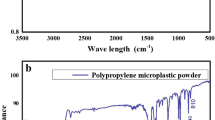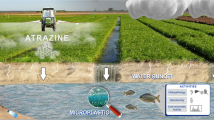Abstract
Microplastics have been detected in a variety of aquatic ecosystems, and the combined effect of microplastics and chemical pollutants has become a matter of increasing concern. We conducted a 12-d co-exposure test of anthracene and spherical or fragmented polyethylene microplastics (size 200 µm) on Java medaka (Oryzias javanicus). The accumulation of anthracene in Java medaka muscle reached a plateau on day 5 in all anthracene exposure groups, and no significant differences were detected among the groups (ANT, 20.4 ± 5.5; ANT + SPPE-MP, 24.7 ± 2.7; ANT + FRPE-MP, 24.6 ± 4.7 µg/g). However, co-exposure to anthracene and spherical or fragmented polyethylene microplastics increased the duration of slow swimming in a swimming behavior test (control, 4.1 ± 1.4; ANT, 5.2 ± 2.8; ANT + SPPE-MP, 12.4 ± 3.7; ANT + FRPE-MP, 17.4 ± 5.1 min/30 min), and co-exposure to anthracene and fragmented polyethylene microplastics induced higher cytochrome P4501A monooxygenase (CYP1A) expression in Java medaka livers than the other anthracene exposure groups (ANT, 189 ± 74; ANT + SPPE-MP, 203 ± 75; ANT + FRPE-MP 272 ± 36% of control). Polyethylene microplastics appear to be weak vectors of anthracene at the size tested (200 µm), and the effect of shape (spherical or fragmented) on the vector effect was small. However, the presence of polyethylene microplastics could affect the swimming behavior and CYP1A expression in Java medaka.






Similar content being viewed by others
References
Auta HS, Emenike CU, Fauziah SH (2017) Distribution and importance of microplastics in the marine environment: a review of the sources, fate, effects, and potential solutions. Environ Int 102:165–176
Bajt O (2021) From plastics to microplastics and organisms. FEBS Open Bio 11:954–966
Botterell ZLR, Beaumont N, Cole M et al. (2020) Bioavailability of microplastics to marine zooplankton: effect of shape and infochemicals. Environ Sci Technol 54:12024–12033
Bucheli TD, Fent K (1995) Induction of cytochrome P450 as a biomarker for environmental contamination in aquatic ecosystems. Crit Rev Environ Sci Technol 25:201–268
Chen Q, Gundlach M, Yang S et al. (2017a) Quantitative investigation of the mechanisms of microplastics and nanoplastics toward zebrafish larvae locomotor activity. Sci Total Environ 584–585:1022–1031
Chen Q, Yin D, Jia Y et al. (2017b) Enhanced uptake of BPA in the presence of nanoplastics can lead to neurotoxic effects in adult zebrafish. Sci Total Environ 609:1312–1321
Gonçalves R, Scholze M, Ferreira AM et al. (2008) The joint effect of polycyclic aromatic hydrocarbons on fish behavior. Environ Res 108:205–213
Gray AD, Weinstein JE (2017) Size- and shape-dependent effects of microplastics particles on adult daggerblade grass shrimp (Palaemonetes pugio). Environ Toxicol Chem 36:3074–3080
Honda M, Suzuki N (2020) Toxicities of polycyclic aromatic hydrocarbons for aquatic animals. Int J Environ Res Public Health 17:1363
Horie Y, Kanazawa N, Yamagishi T et al. (2018) Ecotoxicological test assay using OECD TG 212 in marine Java medaka (Oryzias javanicus) and freshwater Japanese medaka (Oryzias latipes). Bull Environ Contam Toxicol 101:344–348
Karapanagioti HK, Endo S, Ogata Y, Takada H (2011) Diffuse pollution by persistent organic pollutants as measured in plastic pellets sampled from various beaches in Greece. Mar Pollut Bull 62:312–317
Khan FR, Syberg K, Shashoua Y, Bury NR (2015) Influence of polyethylene microplastics beads on the uptake and localization of silver in zebrafish (Danio rerio). Environ Pollut 206:73–79
Koyama J, Kawamata M, Imai S et al. (2008) Java medaka: a proposed new marine test fish for ecotoxicology. Environ Toxicol 23:487–491
Kurihara R, Shiraishi F, Tanaka N, Hashimoto S (2005) Presence and estrogenicity of anthracene derivatives in coastal Japanese waters. Environ Toxicol Chem 24:1984–1993
Lin W, Jiang R, Wu J et al. (2019) Sorption properties of hydrophobic organic chemicals to micro-sized polystyrene particles. Sci Total Environ 690:565–572
Liu Y, Qiu X, Xu X et al. (2021) Uptake and depuration kinetics of microplastics with different polymer types and particle sizes in Japanese medaka (Oryzias latipes). Ecotoxicol Environ Saf 212:112007
Lu K, Qiao R, An H, Zhang Y (2018) Influence of microplastics on the accumulation and chronic toxic effects of cadmium in zebrafish (Danio rerio). Chemosphere 202:514–520
Meijer LJJ, van Emmerik T, van der Ent R et al. (2021) More than 1000 rivers account for 80% of global riverine plastic emissions into the ocean. Sci Adv 7:eaaz5803
Nizzetto L, Lohmann R, Gioia R et al. (2008) PAHs in air and seawater along a North-South Atlantic transect: trends, processes and possible sources. Environ Sci Technol 42:1580–1585
Oliveira M, Ribeiro A, Hylland K, Guilhermino L (2013) Single and combined effects of microplastics and pyrene on juveniles (0+ group) of the common goby Pomatoschistus microps (Teleostei, Gobiidae). Ecol Indic 34:641–647
Our World in Data (2022) Global plastics production. Our World in Data. https://ourworldindata.org/grapher/global-plastics-production
Qiao R, Deng Y, Zhang S et al. (2019) Accumulation of different shapes of microplastics initiates intestinal injury and gut microbiota dysbiosis in the gut of zebrafish. Chemosphere 236:124334
Qiu X, Saovany S, Takai Y et al. (2020) Quantifying the vector effects of polyethylene microplastics on the accumulation of anthracene to Japanese medaka (Oryzias latipes). Aquat Toxicol 228:105643
Qu H, Ma R, Wang B et al. (2018) Effects of microplastics on the uptake, distribution and biotransformation of chiral antidepressant venlafaxine in aquatic ecosystem. J Hazard Mater 359:104–112
R Core Team (2022) R: a language and environment for statistical computing. R Core Team, Vienna, Austria
Romano N, Renukdas N, Fischer H et al. (2020) Differential modulation of oxidative stress, antioxidant defense, histomorphology, ion-regulation and growth marker gene expression in goldfish (Carassius auratus) following exposure to different dose of virgin microplastics. Comp Biochem Physiol C Toxicol Pharmacol 238:108862
Rusni S, Sassa M, Takehana Y et al. (2020) Correlation between cytochrome P450 1A (cyp1a) mRNA expression and ambient phenanthrene and pyrene concentration in Javanese Medaka Oryzias javanicus. Fish Sci 86:605–613
SAPEA (2016) A scientific perspective on microplastics in nature and society. SAPEA
Sarasquete C, Segner H (2000) Cytochrome P4501A (CYP1A) in teleostean fishes. A review of immunohistochemical studies. Sci Total Environ 247:313–332
Scott GR, Sloman KA (2004) The effects of environmental pollutants on complex fish behaviour: integrating behavioural and physiological indicators of toxicity. Aquat Toxicol 68:369–392
Takai Y, Tokusumi H, Sato M et al. (2022) Combined effect of diazepam and polystyrene microplastics on the social behavior of medaka (Oryzias latipes). Chemosphere 299:134403
Xia X, Sun M, Zhou M et al. (2020) Polyvinyl chloride microplastics induce growth inhibition and oxidative stress in Cyprinus carpio var. larvae. Sci Total Environ 716:136479
Xiong X, Tu Y, Chen X et al. (2019) Ingestion and egestion of polyethylene microplastics by goldfish (Carassius auratus): influence of color and morphological features. Heliyon 5:e03063
Yamanaka O, Takeuchi R (2018) UMATracker: an intuitive image-based tracking platform. J Exp Biol 221:jeb182469
Yin L, Chen B, Xia B et al. (2018) Polystyrene microplastics alter the behavior, energy reserve and nutritional composition of marine jacopever (Sebastes schlegelii). J Hazard Mater 360:97–105
Yin L, Liu H, Cui H et al. (2019) Impacts of polystyrene microplastics on the behavior and metabolism in a marine demersal teleost, black rockfish (Sebastes schlegelii). J Hazard Mater 380:120861
Yu Q, Hu X, Yang B et al. (2020) Distribution, abundance and risks of microplastics in the environment. Chemosphere 249:126059
Acknowledgements
We would like to express our heartfelt gratitude to Nobuyuki Ohkubo (Japan Fisheries Research and Education Agency) for generously lending us the plastic cutting mill, which was essential for our experiments. We are deeply grateful to editors from ELSS, Inc. (https://www.elss.co.jp/en/) for English proofreading of the manuscript. This work was partly supported by a Japan Society for the Promotion of Science KAKENHI grant (JP21H05058), a Long-range Research Initiative by the Japan Chemical Industry Association (19_R05-01), and the cooperative research program of the Institute of Nature and Environmental Technology, Kanazawa University (20061).
Author information
Authors and Affiliations
Contributions
YT: conceptualization, formal analysis, investigation, writing—original draft, funding acquisition. AT: conceptualization, formal analysis, investigation. MH: funding acquisition, writing—review and editing. XQ, YS, and IJK: supervision, writing—review and editing. YO: conceptualization, supervision, funding acquisition, writing—review and editing.
Corresponding author
Ethics declarations
Conflict of interest
The authors declare no competing interests.
Ethical approval
All experiments in this study were carried out according to the Guidelines for Animal Experiments of Kyushu University (license A20-335-0).
Additional information
Publisher’s note Springer Nature remains neutral with regard to jurisdictional claims in published maps and institutional affiliations.
Rights and permissions
Springer Nature or its licensor (e.g. a society or other partner) holds exclusive rights to this article under a publishing agreement with the author(s) or other rightsholder(s); author self-archiving of the accepted manuscript version of this article is solely governed by the terms of such publishing agreement and applicable law.
About this article
Cite this article
Takai, Y., Tominaga, A., Honda, M. et al. Combined effect of anthracene and polyethylene microplastics on swimming speed and cytochrome P4501A monooxygenase expression of Java medaka (Oryzias javanicus). Ecotoxicology 32, 948–957 (2023). https://doi.org/10.1007/s10646-023-02700-4
Accepted:
Published:
Issue Date:
DOI: https://doi.org/10.1007/s10646-023-02700-4




